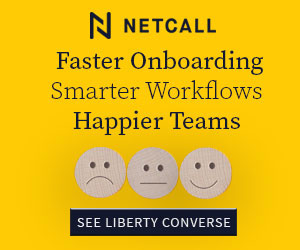It’s no secret that conversational AI is transforming contact centres. Organizations already using the technology are reporting impressive benefits.
Until now, though, smaller organizations have not enjoyed the same access to AI solutions and their benefits due to the large IT budgets and resources required to support implementation.
This divide is shifting, though. Enter the next phase in the evolution of AI for contact centres—one that involves leveraging the power of generative AI to democratize access for organizations of all sizes.
To understand how this next phase will play out, Karina Howell at 8×8 takes a closer look at why expanding access to AI matters to customer experience (CX) leaders, why the advances of generative AI is a game changer, and how adoption by small- to mid-sized organizations is likely to play out.
End Users Confirm Current Benefits
Let’s start by looking at the benefits reported in a recent 8×8 survey of contact centre leaders:
- 92% of respondents confirm that using the technology allows their organization to resolve customer issues faster
- 94% confirm that AI improves agent productivity
- 87% confirm that the use of conversational AI in their contact centre has reduced effort for agents.
Faster customer issue resolution translates to improved CX, while reduced agent effort translates to improved agent productivity, engagement and overall operational efficiency.
These are just a few of the impressive benefits reported by this survey, painting a clear picture of the transformational power of AI.
Industry Analysts Project Future Benefits
Leading industry analysts project that the competitive advantage AI confers for contact centres already using the technology will only accelerate.
- For example, Gartner projects that “as the virtual agent workload increases, these agents have the potential to drive self-service to the 20% to 30% range or more, with the human agent side diminishing.”
- Metrigy projects that 65.7% of inquiries will be resolved by AI in 2025 within organizations that have already adopted the solution
- Metrigy further reports that contact centres without AI will need 2.3 times more agents than those with AI
Barriers for Smaller Contact Centres
Why are the benefits not more evenly distributed? It turns out that smaller contact centres encounter limitations, barriers, and constraints to adoption on a larger scale than do larger contact centres.
The same 8×8 survey of contact centres leaders finds that:
- 34% of small contact centres consider budget constraints to be a major barrier to adopting AI, compared to 9% of large contact centres
- 26% of small contact centres cite technology limitations as a major barrier to adopting AI, while only 6% of medium to large contact centres report the same
In short, the number of large contact centres reporting barriers to adoption is only in the single digits because these organizations possess extensive internal implementation resources.
While small- to mid-sized contact centres recognize the benefits of AI, they lack resources to support the initial implementation, and this presents a major barrier.
Bridging the Competitive Gap
Ultimately this lag in adoption puts small contact centres at a disadvantage, since AI directly improves the customer experience.
Customers become accustomed to the more rapid, convenient, and engaging experiences they encounter in larger organizations, and this raises the bar for organizations of all sizes.
So, how to bridge the competitive gap and compete on a level playing field with larger organizations? We recommended two ways:
1. By Accessing Generative AI.
Generative AI refers to technology powered by large language models that offer more conversational experiences.
It doesn’t require the same high implementation and maintenance costs as other forms of conversational AI because it is able to perform original content creation based upon an array of training data.
It also offers advanced studio frameworks that help non-technical contact centre leaders deploy and manage experiences without IT involvement.
2. By Accessing AI Through an Existing Contact Centre Solution
According to 8×8’s survey, 85% of contact centre leaders prefer to access AI through an integrated CCaaS suite. This minimizes integration costs, making the solution more accessible to smaller contact centres and businesses.
The first step in realizing the promise of Generative AI in democratizing access to the benefits of automation is choosing an integrated CCaaS solution.
Most organizations will look to generative AI to make self-service more effective by deploying virtual agents.
Many others will look to improve agent efficiency with an agent assist solution. On the whole, this will usher in a new phase of AI deployment, one that levels the CX playing field for contact centres of all sizes.
This blog post has been re-published by kind permission of 8x8 – View the Original Article
For more information about 8x8 - visit the 8x8 Website
Call Centre Helper is not responsible for the content of these guest blog posts. The opinions expressed in this article are those of the author, and do not necessarily reflect those of Call Centre Helper.
Author: 8x8
Published On: 15th Jan 2024 - Last modified: 9th Dec 2024
Read more about - Guest Blogs, 8x8






 8x8 is transforming the future of business communications as a leading Software-as-a-Service provider of voice, video, chat, contact centre, and enterprise-class API solutions, powered by one global cloud communications platform.
8x8 is transforming the future of business communications as a leading Software-as-a-Service provider of voice, video, chat, contact centre, and enterprise-class API solutions, powered by one global cloud communications platform. 
































